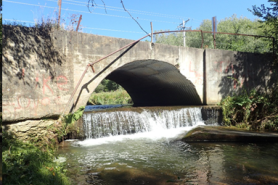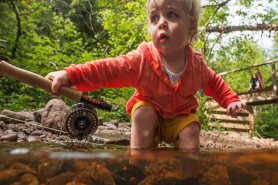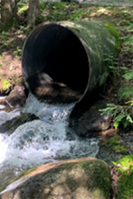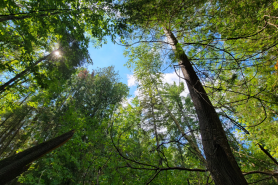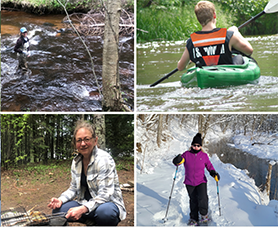Wisconsin's Brook Trout Reserves
Fishing Wisconsin
Conserving a Native Stream Trout In a Warming World: Confronting the Challenges of Climate Change
Brook trout are a beautiful yet sensitive fish. They are the only stream trout native to Wisconsin, and their homes are the cold, clear streams that meander the state's landscape. But brook trout are losing their homes. Two of every three streams they reside in now are project.ed to be too warm in 30 years. The remaining places should be considered brook trout strongholds where streams can stay cold and brook trout thrive. We call these our Brook Trout Reserves, and we've identified their locations in the top streams in Wisconsin.
A Story That Needs Telling
Conserving a Native Stream Trout in a Warming World is an interactive DNR StoryMap that describes the future plight of the brook trout in Wisconsin, identifies the challenges it faces and introduces the development of the Brook Trout Reserves and their importance in conserving brook trout in a warming world.
The Brook Trout In Wisconsin
Identification
How Do You Identify A Brook Trout?
Brook trout are strikingly colorful fish. Many anglers consider brook trout the most beautiful sport fish in Wisconsin.
Brook trout are generally olive, blue-gray, or black on the back and white on the belly. They also have worm-like markings called vermiculations on their back and red spots (sometimes surrounded by bluish halos) on their sides. There are black and white stripes along the front edges of the lower body fins, and the remainder of these fins are reddish. The lower flanks and belly of breeding males become orange-red with black pigmentation on either side of the belly. Lake-run brook trout (coasters) are more silver over the head and body, and less heavily pigmented. Brook trout young have seven to nine large, brown parr marks along their lateral line.
Males are usually smaller and more colorful than females. Under normal conditions, a one-year-old brook trout is 6-10 inches, and a two-year-old fish is 8-13 inches.
Distribution
Where Are Brook Trout Found?
Brook trout occur throughout the state, principally in central and northern Wisconsin, Lake Superior and Lake Michigan (the Lake Michigan population is sustained through stocking).
The species is common in central and northern Wisconsin streams, and rare to uncommon in southern Wisconsin, except in Richland, Columbia, Dane and Sauk counties, where it is common in many streams.
Brook trout inhabit cool, clear, headwater spring ponds, springs and spring-fed streams. Wisconsin has an estimated 21,000 miles of suitable cold-water stream habitat for brook trout.
Biology
How Do Brook Trout Reproduce And Develop?
Male brook trout typically mature and spawn at ages one and two, while female brook trout normally begin spawning at ages two and three. Spawning generally starts in early October and ends in December, with peak spawning around mid-November. A female brook trout might produce 300-400 eggs. After spawning, the female will cover the eggs with gravel, up to eight inches, in some cases.
Brook trout spawning generally occurs near springs because the eggs depend on steady water percolation through the gravel for aeration. The length of the egg incubation period depends on water temperature.
Once hatched, brook trout sac fry remain in the gravel nest (redd) until the yolk is absorbed. The fry (less than an inch) typically emerges from the redd between January and April. They need a rearing habitat with low water velocity and protective cover during their first month or two following emergence. During spring, brook trout fry can often be seen along the margins of streams. Small trout are vulnerable during spring flood events that may wash them out of streams.
Brook Trout And The Threat Of Climate Change
Wisconsin is getting warmer and wetter (as demonstrated in the WICCI 2021 Assessment Report [exit DNR]), and trout streams are no exception. They are warmer, have stronger flows and experience more extreme floods more often.
Since the 1990s, these shifts have contributed to tougher conditions for brook trout. Adult densities and successful reproduction are both declining. According to a research paper that analyzed DNR trout survey data [exit DNR], statewide average abundance estimates of young-of-year fish peaked in 2008, and, after that, declined. Adult brook trout have declined throughout the entire period. These changes are strongly associated with climatic conditions – brook trout populations do poorly after hot years, especially in the southern part of the state, and, while heavy precipitation in the summer and fall can actually benefit brook trout, extreme storms and flooding in the winter or spring can have drastic effects on the survival of eggs and young brook trout.
According to a 2019 research paper, the changes that have made conditions more challenging for brook trout are projected to continue [exit DNR], which will affect the amount of habitat available to brook trout in the future. By the middle of the century, two out of every three miles of currently suitable habitat are projected to become unsuitable based on temperature changes. In total, over 15,000 suitable stream miles out of over 22,000 are likely to be lost.
To learn more about the effects of climate change on brook trout and Wisconsin streams, you can read reports from the Fisheries Working Group [exit DNR] and the Water Resources Working Group [exit DNR] of the Wisconsin Initiative on Climate Change Impacts.
Actions can be taken to give brook trout a better chance to thrive in a warmer, wetter climate. We can try to keep streams as cool as possible and mitigate floods through actions in the riparian zone and watersheds. We can also try to remove or reduce the additional threats, like movement barriers, to give brook trout a better chance to withstand warming and increased precipitation effects.
The Wisconsin Initiative on Climate Change Impacts Fisheries working group also recommended allocating management resources to places where brook trout are most likely to succeed. DNR Fisheries Management and our partners agree, so we are taking significant steps to confront this challenge by identifying the most resilient brook trout systems, which we call Brook Trout Reserves. The designation of Brook Trout Reserves enables DNR and partners to focus on instream, riparian and watershed management actions that aim to offset the impacts of rising air and water temperatures and changes in precipitation.
Brook Trout Reserves
These habitats are the places in Wisconsin where brook trout have the best chance of enduring the effects of climate change and other environmental challenges.
It is challenging to find the best streams where brook trout and their habitat are most likely to persist in the face of a warming climate. Fortunately, DNR Fisheries staff have access to great science (USGS Fish Viz [exit DNR]), ample data (Fisheries Management Information System), (Wiscland 2.0) and the power of geographic information systems (GIS) to help meet the challenge.
The Brook Trout Reserves team has used the best science available to develop criteria to identify and evaluate 54 reserves statewide. These strongholds represent the best brook trout populations and their habitat, which will likely persist in the face of climate change. The reserves represent 22% of today's brook trout habitat in the state, and, by the year 2050, will represent 33% of all brook trout habitat. All of the 205 brook trout reserve sub-watersheds contain:
- Self-sustaining, naturally reproducing populations.
- Brook trout abundance is currently above average and exceeds nonnative trout and salmon.
- Limited or no brown trout stocking.
- Greater than two miles of brook trout habitat remaining by the year 2050.
The DNR's Brook Trout Reserves team's homework, data analysis and detailed mapping among the 54 Brook Trout Reserves is available in a map book [PDF].
The reserves are different and have different threats and opportunities. The Brook Trout Reserves team developed a four-class framework to aid resource managers in identifying the reserves' primary threats, collaborating on planning and selecting the most important management tools, including land use, groundwater protection, afforestation/reforestation of riparian areas, stream crossings and fish passage, land acquisition, in-stream habitat and stocking.
Exploring The Reserves
Use this interactive map with your mouse to zoom and pan to view classified trout water and the Brook Trout Reserves throughout Wisconsin.
Types Of Reserves
Environmentally Resilient—Vigilance: These reserves are the most resilient to the ongoing impacts of climate change and have the most habitat protected by public ownership.
Environmentally Resilient – Secure Habitat: These reserves have high environmental resilience, but their riparian areas have little public land. There are ample opportunities to secure and protect habitat.
Naturally Vulnerable – Limited Opportunities: These reserves possess excellent watershed and riparian health. However, their low groundwater contribution makes them naturally vulnerable. Providing fish passage between important seasons and life history habitats will be critical.
Vulnerable – Rehabilitation Opportunity: These reserves are most vulnerable; however, adaptation strategies can be implemented to protect them.
Additional Threats To Brook Trout
As the climate becomes warmer and wetter, it is not only water temperature and streamflow that can make conditions more challenging for brook trout. There are additional threats to brook trout that are likely to be made worse by climate change or that can hinder brook trout populations' ability to withstand climate change. Those additional threats are:
Land Use Change
Suitable brook trout habitat consists of groundwater-fed cold, well-oxygenated, free-flowing streams that run through healthy watersheds. According to the Healthy Watersheds, High-Quality Waters action plan, a healthy watershed is the area draining to the stream where natural land cover supports ecological processes, habitat, connectivity and water quality. Watersheds where 75% of the land is in natural land cover are deemed healthy. Forests and wetlands are especially beneficial for brook trout habitat.
Forests
Brook trout populations are most successful in watersheds with high forest cover. For example, in the eastern U.S., for a watershed to be considered high-quality for brook trout, researchers suggested that at least 65% of the land cover be forested [exit DNR]. However, that threshold may be lower in the Midwest [exit DNR]. Forested watersheds tend to have cooler streams, better groundwater recharge and higher water quality than agricultural or urban watersheds. Wisconsin's land cover was rapidly changed in the late 1800s and early 1900s when forests declined due to intense logging. In recent decades, however, forest land cover has increased, especially in the northern and eastern parts of the state, although declines in the southern and western regions could be an additional threat to brook trout. For more details on these trends, read UW-Stevens Point's reports on land use trends [exit DNR].
Wetlands
Wetlands are also an important component of the land cover within brook trout watersheds, and 47% of the original wetland acreage in Wisconsin has been lost. Given a changing climate, wetlands are especially important for mitigating stream flooding and recharging groundwater. Groundwater is critical to brook trout streams. Brook trout will only spawn where groundwater is upwelling into the stream. From a climate change perspective, groundwater is increasingly important because it has a buffering effect on stream temperatures, helping keep streams cold even during hot summers, and is crucial to brook trout in less forested watersheds. Read more on how wetlands can benefit trout in Wisconsin [exit DNR].
Aquatic Connectivity
Brook trout conservation (adaptation success) will depend on restoring and protecting coldwater refugia in main stream stems and removing physical and physicochemical barriers to trout movement near tributary and main-stem confluences. Across the landscape, undersized, aging and improperly placed stream crossings fragment aquatic habitats and prevent brook trout from moving between important seasonal and life history habitats.
When one hears the term "fish passage," the first thing that often comes to mind is salmon of the Pacific Northwest migrating up West Coast river systems and the importance of these species returning to their natal streams. At the same time, while our native brook trout may not travel thousands of miles like their distant relatives, maintaining aquatic connectivity is an integral part of their life history.
Aquatic connectivity includes the safe passage of fish and other aquatic organisms within a hydrologically functioning stream connected to its floodplains, but throughout the entire watershed. Brook trout require open stream systems to use spawning habitat, feeding areas, nursery habitat and thermal refuge in the face of a predicted warmer climate. Restoring and maintaining aquatic connectivity will be an integral part of maintaining the function of Brook Trout Reserves.
Competition From Brown Trout
In the Midwest, nonnative brown trout often displace brook trout when the two co-occur, especially when brown trout densities are high. Separate brook trout populations are usually found in headwater streams with cold and stable water temperatures, whereas the populations that include brown trout are found downstream in slightly warmer streams. Recent research conducted by UW-Madison and the Wisconsin DNR documented statewide declines in the abundance of young-of-year and adult brook trout since 2006 [exit DNR], while brown trout abundance has increased. Our warming climate is now likely compounding the competitive displacement of brook trout by nonnative, naturalized brown trout.
The competitive displacement of brook trout by brown trout is common. However, a recent Minnesota Department of Natural Resources study underscored the rare situation where a stream becomes colder under our warming climate, a stream becomes colder, and brook trout can displace brown trout [exit DNR].
There are several potential reasons why this happens. Competition between brown trout and brook trout may lead to differences in reproductive success and survival, favoring one species over another. University of Manitoba researchers demonstrated a sub-lethal temperature threshold (68-74°F), beyond which the brook trout experienced reduced physiological performance [exit DNR]. A 2024 study by the Wisconsin DNR showed that brown trout displacement of brook trout is primarily influenced by stream temperature [exit DNR]; removal of brown trout at the stream reaches with warmer summer temperatures resulted in the highest benefit to the abundance of brook trout.
This thermal stress is likely most excellent for brook trout in southern Wisconsin, where average temperatures are warmer. Additionally, parasites and pathogens that affect brook trout in their native environment may not affect brown trout, giving them a competitive advantage.
Management Actions To Help Brook Trout
To thrive in a warming world, brook trout need streams that remain as cold as possible, where flooding is limited and other threats to brook trout are minimized. The actions below represent a portfolio of different options that may be important to long-term brook trout conservation within Brook Trout Reserves:
Acquiring Habitat In The Stream Corridor
-
Stream Bank Protection
Brook Trout Reserve streams throughout the southern two-thirds of Wisconsin are eligible for habitat protection funding through the Knowles-Nelson Stewardship - Stream Bank Protection Program. This critical and popular program protects our coldwater fisheries, water quality and riparian habitat for the future by purchasing easements directly from landowners. In return for payment, the landowner allows public fishing and DNR management activities along the stream corridor on their property. The easement area is generally 66 feet of land from the stream bank on either side of the stream. Easements are perpetual and remain on the land even if sold or deeded to an heir. Please get in touch with your local fisheries biologist for further information, or visit the Knowles-Nelson Stewardship - Stream Bank Protection Program (SBP) webpage.
New Protection Opportunities
The DNR's Fisheries Management Program is also pursuing new opportunities to secure and protect coldwater stream habitat for Brook Trout Reserves in the northern one-third of the state. This new master plan proposal seeks authority to purchase fisheries management easements from willing landowners among 28 of the 42 Brook Trout Reserve subwatersheds in the North Central Forest Ecological Landscape. These Brook Trout Reserve easements aim to protect the stream and its riparian zone and provide public access (except hunting and trapping). The DNR intends to acquire forest management, development, instream habitat and agency trapping rights along riparian areas. Easement widths typically range between 66 and 300 feet from each stream bank.
Brook Trout Reserve 41
Located in northeast Wisconsin's Peshtigo, Brook Trout Reserve 41 is the state's largest brook trout reserve. You can learn more about the collaboration to develop a 10-year Aquatic Connectivity Strategic Plan by visiting the Brook Trout Reserve 41 webpage.
Take Action
Taking action throughout the watersheds of trout streams can protect and improve trout habitat, as emphasized by the DNR's Healthy Watersheds, High-Quality Waters program. Thus, taking action to conserve and restore land use in the watersheds of the Brook Trout Reserves will help brook trout withstand the effects of climate change. Conservation of high-quality areas within watersheds may consist of simply being vigilant to ensure continued conservation of already protected healthy lands, and protecting additional lands via land acquisitions by federal, state or conservation organizations, easement acquisitions or thoughtful stewardship by private landowners. Restoring watersheds to a healthy status that could help sustain high-quality brook trout habitat may require reforestation, sustainable forest management, and wetland restoration. Protecting and restoring land covers that help ensure good water quality and recharge groundwater to enhance spawning potential and keep streams cool are critical actions we can take to help brook trout thrive in a warmer, wetter climate.
Connecting Critical Habitats
-
Identify And Rectify Road Crossing Impairments
Continue collaborations to identify, inventory and prioritize barriers to the movement of native brook trout and plan and implement appropriate aquatic connectivity actions. Please contact your local fisheries biologist if you find perched or poorly sized culverts along a brook trout stream.
An inventory of road-stream crossings can be found at the Great Lakes Stream Crossing Inventory (arcgis.com). This site will also provide newly developed protocols intended to promote consistent data collection, selection criteria for improvement projects and selection of appropriate Best Management Practices for each project to benefit all stakeholders. Information gathered can and has been used to prioritize structure replacement and successfully seek funding. To date, over 2,000 sites within Brook Trout Reserves have been surveyed and entered into the Great Lakes Stream Crossing Inventory. Funding opportunities may be available through the National Fish Passage Program and Great Lakes Restoration Initiative.
Planning And Partnering
As anglers, landowners, farmers, foresters and Wisconsinites, we must all play our part. Communities must be engaged and work together for brook trout to persist in our state. Consider joining and participating in a local conservation club or watershed group to help protect and manage these special places. To find local conservation clubs or watershed groups in your area of interest, please get in touch with your local fisheries biologist.
Brook Trout Reserves are special places that deserve our attention. Help protect them.
Planting Trees In The Stream Corridor
-
Restore Shade
When you are wading in a brook trout stream on a sunny day, look into the midday sun. If your eyes burn, it's likely getting too warm for brook trout! Brook trout need cold, clear streams. Streamside forests provide important shade and are critical for offsetting the effect of climate warming on stream temperature.
The DNR's Reforestation Program grows high-quality native tree seedlings and shrubs to plant on private, public and tribal lands for conservation. These seedlings can provide future forest products, wildlife habitat, soil erosion control, living snow fences, carbon sequestration, aesthetics and, most importantly, streamside shade and cold water for brook trout.
Not only are trout streams changing, but so are our forests. USDA Northern Forests Climate Hub and the Northern Institute of Applied Climate Science have authored Tree Species Projections for Ecological Sections in Northern Wisconsin [exit DNR] and Southern Wisconsin [exit DNR]. When developing a planting plan, these guides can help land managers consider climate change risks and local site characteristics.
Please contact your DNR service forester in the county where you will be planting the trees for technical assistance in developing a planting plan and selecting appropriate species for your site.
Protecting Habitat In The Stream Corridor
-
Healthy Forestry Practices
Forests play an important role in the water cycle, contributing to the high-quality water found in Wisconsin's brook trout streams. The DNR's Forestry Best Management Practices (BMPs) for Water Quality Manual provides practical ways to protect stream health through forest management.
Let The Dead Trees Lie
Trees falling in our streams are as natural as trees falling in the forest. Many animals live and raise their young in these downed trees. Limiting the disturbance of our natural shores helps our stream habitat stay healthy.
Explore, Discover And Connect
We are all drawn to water; these are very special Wisconsin waters! The beauty of these Brook Trout Reserves is obvious whether you're fishing, taking photographs, berry picking, hiking, skiing or snowshoeing. Grab a map and explore these beautiful places near you.
Sign Up For More Information
Contact Information
For more information on Brook Trout Reserves in Wisconsin, please contact Annaliese Ford, Brook Trout Reserves Project Coordinator
at annaliese.ford@wisconsin.gov or send a message to DNRFHBrookTroutReserves@wisconsin.gov.









